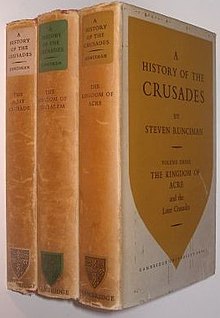A History of the Crusades

(publ. Cambridge University Press)
A History of the Crusades by
It has seen numerous reprints and translations and in some respects has come to be seen as a standard work on the topic. Its scope encompasses the ascendancy of Islam in the Levant during the early 7th century until the fall of Acre in 1291, with later chapters covering through 1464, the time of Pope Pius II.
The work draws on a wide range of primary sources in Greek, Latin, Armenian and Arabic. At the time of its initial publication, it offered a novel interpretation of the crusades as less as a defensive war of Christendom against the threat of
The review of the first volume by the Egyptian historian Aziz Atiya was generally positive, with the view that the work would fill a much needed gap between René Grousset's work published in 1934 and the planned Wisconsin Collaborative History of the Crusades (for which Runciman contributed four chapters).[1] Runciman's approach, while it may have had value in overcoming overly romantic views of the crusades held in the 19th century, has not aged well and is now seen as having gone beyond the mark by painting the crusaders as "simpletons or barbarians".[2]
Thomas F. Madden (2002) called the work "terrible history yet wonderfully entertaining".[3]
That criticism might have been encouraged by Runciman's own attitude, which embraced subjectivity and polemics. He described his approach in the first volume of A History of the Crusades as his "one pen against the massed typewriters of the United States". Runciman believed, "The historian must attempt to add to his subjective study the qualities of intuitive sympathy and imaginative perception, without which he cannot hope to comprehend the fears and aspirations and convictions that have moved past generations".[4] This statement is a key to understanding his unique style but also explains much of the criticism leveled at it.
It is nevertheless undisputed that the work contains genuine scholarship and has been very influential on the generation of scholars educated during the 1950s to the 1970s. Bernard Hamilton wrote in 2000: "The first two volumes of Sir Steven’s History of the Crusades were published while I was an undergraduate. I read them with avidity […] I still think that his History is one of the great literary works of English historical writing, which has inspired an interest in and enthusiasm for the crusades in a whole generation".[5]
References
- ^ Atiya, A. S. (1952). Review of A History of the Crusades, by S. Runciman. Speculum, 27(3), 422–425.
- ISBN 9780742538221.
- ^ Thomas F. Madden, “The Real History of the Crusades” Archived August 2, 2008, at the Wayback Machine.Crisis Magazine, April 1, 2002, 2. (accessed October 27, 2008).
- OCLC 387160.
- ISBN 9781107050662.
